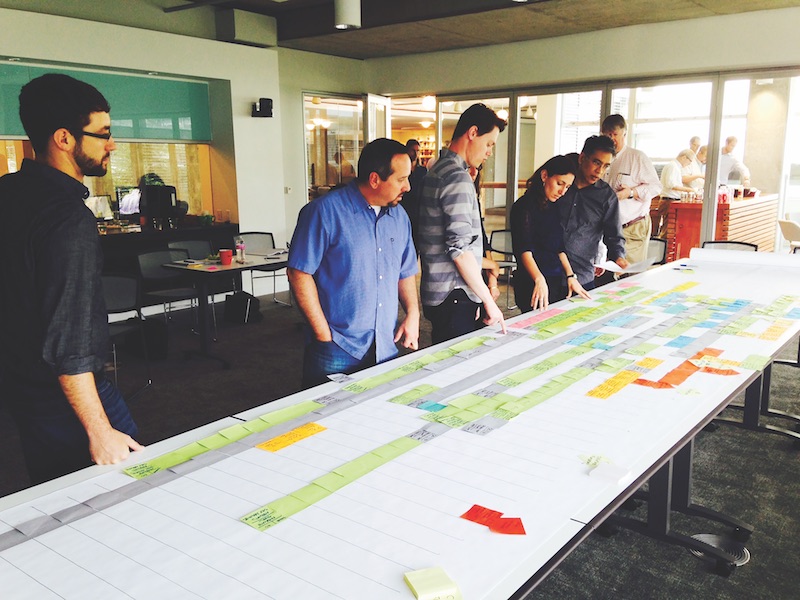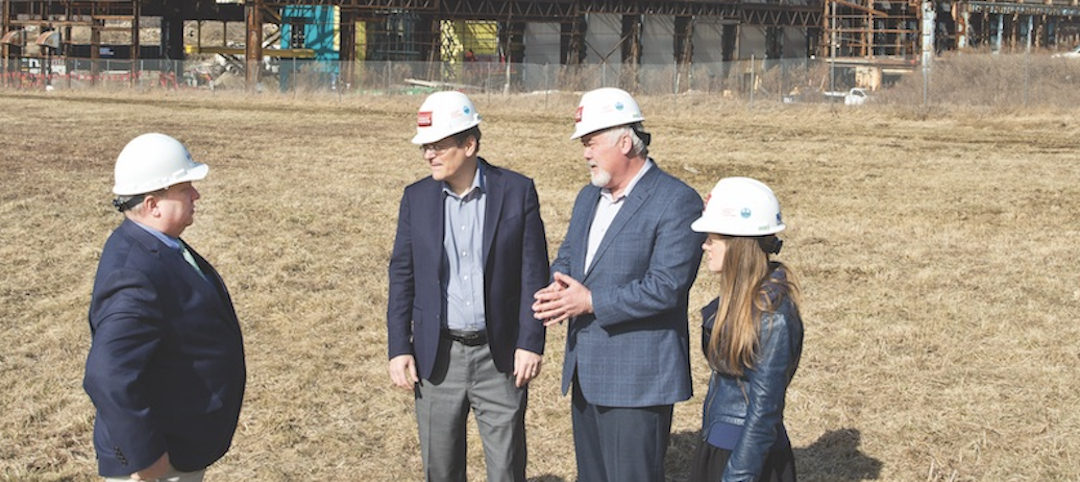The Lean construction movement is on the march. Its parent organization, the Lean Construction Institute, celebrated its 20th anniversary last year. LCI now has 218 corporate members, 38 owner members, and 31 active Communities of Practice. Its 2017 conference attracted more than 1,500 attendees, from 125 countries.
There’s also been a noticeable bump in client interest in Lean lately. “Over the last year or so we’ve been seeing a lot of RFPs from clients, mostly healthcare and tech companies, asking for our Lean skills,” says Skanska USA Building’s Kevin McCain.
Brasfield & Gorrie’s Katie Wells concurs: “We’re seeing an increase in client requests for Lean applications, especially in large healthcare work, but Last Planner”—the core system for Lean planning—“and other Lean tools can be used even for small projects.”
Lean enthusiasts like Felipe Engineer-Manriquez, Corporate Lean Manager at McCarthy Building Cos., believe Lean can work everywhere. “Every single project, no matter the size, can be Lean,” he says.
For many GC firms, tangible results from implementing Lean can vary from project to project, depending on a lot of factors. JE Dunn’s experience is typical. “We have seen as much as a 25% schedule savings, and we have regularly returned contingency dollars to the client,” says Rebecca Snelling, JE Dunn’s National Director of Lean Construction. More important to many firms are the intangibles, such as “cultural change” and “enhanced work/life balance” that they see coming from adopting Lean into their processes.
Recent LCI-sponsored research studies make a compelling case for employing Lean principles in building design and construction. One study of 162 projects found that those with high Lean intensity were three times more likely to be completed ahead of schedule than low-Lean-intensity projects and were twice as likely to come in under budget than projects with lesser Lean involvement.
An LCI/AIA-sponsored study of 310 designers across 610 projects compared those projects with “very high Lean intensity” to those with “low Lean intensity.” More than half (53%) of the “very high” projects came in under budget, vs. only 7% of “low-intensity” projects; one-third (33%) of the “very high Lean” group also beat the original schedule, compared to only 7% of “low-intensity” projects.
More telling is that 36% of the “very high Lean” projects reported opportunities for design innovation, high levels of sustainability, and “progressive aesthetics,” versus 10% for low Lean projects. In other words, intense use of Lean not only saved time and money, it often produced greener, more beautiful buildings. (For more on LCI research, and to view video interviews with four owners—T. Rowe Price, Rocky Mountain Institute, UC San Francisco, and Sutter Health—go to: bit.ly/2o6BLUN.)
The basic ingredients of Lean design and construction go back more than 40 years, when Toyota, guided by the writings of “total quality” advocate W. Edwards Deming (1900-1993), implemented “continuous improvement” in its plants—and crushed the U.S. automotive industry.
 A project team in Skanska’s Seattle office works with design partners in a Lean pull planning session for a development in downtown Seattle. “We use pull scheduling to get collaboration on projects, and it also gives us greater reliability on the schedule,” says Kevin McCain, Seattle office head and chair of the firm’s National Lean Committee.
A project team in Skanska’s Seattle office works with design partners in a Lean pull planning session for a development in downtown Seattle. “We use pull scheduling to get collaboration on projects, and it also gives us greater reliability on the schedule,” says Kevin McCain, Seattle office head and chair of the firm’s National Lean Committee.
In the U.S., a core group of pioneers spent the better part of two decades adapting the principles of Lean from the manufacturing plant to the construction site—pioneers like LCI co-founders H. Glenn Ballard, PhD, now Research Director, Project Productivity Systems Lab, UC Berkeley, and Gregory A. Howell; Victor Sanvido, PhD, now Senior Vice President, Southland Industries; Lauri Koskela, PhD, now Professor of Construction and Project Management, University of Huddersfield (UK), and a founder of the International Lean Construction Institute; and lawyer Will Lichtig, now with The Boldt Company, who wrote the definitive Integrated Form of Agreement (IFOA) for Lean Project Delivery.
Today, the Lean construction garden is dotted with a robust bloom of abbreviations (LPS, PDCA, 5S, 3P, TPM, TVD); exotic terms of Japanese origin (Kaizen, Kanban, Andon, and muri—not to be confused with muda or mura); and even some phrases with a comic twist: “Poke Yoke,” “Fishbone Diagram,” and the ominous “Last Responsible Moment.”
We talked to experts at eight GC firms to get a reading on their Lean construction agendas.
Gilbane: A DECADE OF LEAN PROGRESS
Gilbane Building Company has been using Lean methods since 2007. “Our A players serve as mentors to identify constraints, plan for handoffs, and eliminate gaps, so that our young project engineers can learn and grow, and the whole project team becomes a unified entity,” says Susan S. Klawans, Senior Vice President and Director of Operational Excellence and Planning.
Gilbane uses its own version of Last Planner (“Gilbane Advanced Planning & Scheduling”) for pull planning, milestone scheduling, and weekly work planning to create “a whole thought/work process,” says Klawans. She’s in charge of the firm’s Quality in Construction program, which assures quality planning and verification on projects like the award-winning $98.3 million, 203-bed buildout (with Albert Kahn Associates) at the University of Chicago Medicine Center for Care & Discovery (bit.ly/2ne8wOy).
The 2,688-member firm is using Lean methods in its safety program to measure not just lost time and recordable incidents, but near misses as well. “It might mean walking up to a laborer who’s cutting masonry and making sure there’s respiratory equipment and water,” she says. “That might prevent a near miss.”
Gilbane gathers client feedback after 90 days to take the customer’s “pulse” and determine what actions the project team should take for improvement. “We’ve always surveyed at the end, but now we’re not waiting till then to get feedback,” says Klawans, who joined Gilbane in 1984.
PPC (Plan Percent Complete—the number of assignments completed that day divided by total assignments for the week) is another Lean metric Gilbane is using. “How many of the commitments we made last week actually were fulfilled?” she asks. “Did all six laborers show up to do the taping? No? Why not? We’re posting that data on our internal website.”
Klawans is leading Gilbane on an updated three-pronged Lean strategy: 1) developing Lean practitioners across the company—in accounting, administration, etc.—not just for building projects; 2) advancing project teams to help owners, designers, and contractors be more effective, and 3) creating “playbooks” of effective enterprise-wide policies and procedures. “Lean comes from the bottom up, and these playbooks will give everyone ‘principle-based guidance’ to make smart decisions and get results,” says Klawans.
Brasfield & Gorrie: respect for people
Katie Wells, LEED AP, Director of Lean Construction, traces Brasfield & Gorrie’s entry into Lean to 2008 and the Texoma Medical Center, a 252-bed Greenfield replacement hospital in Denison, Texas. “It was a design-build contract that was halfway through design,” she says. Executives from the client, Universal Health Services (UHS), had gone to an LCI congress, and they wanted to explore Lean and integrated project delivery (IPD).
Brasfield and design partner HKS couldn’t convert the contract to an IPD, but they did bring in Lean consultants to implement Lean pull planning. “The project paved the way for us” into Lean and IPD, says Wells.
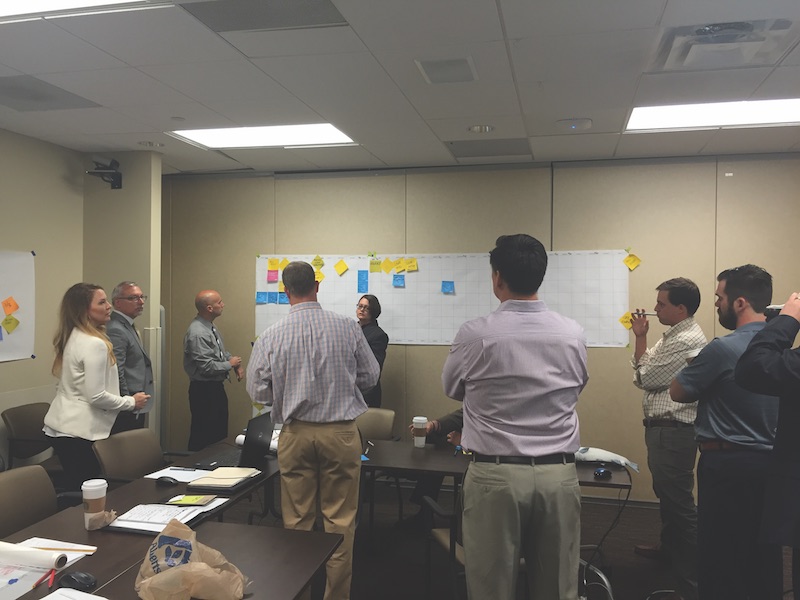 Contractor Brasfield & Gorrie, architect HGA, and subcontractors conduct a Lean pull plan session in a Big Room for United Health System’s Spring Valley Hospital, Las Vegas. The IPD partners made a profit and returned $2.5 million to the client.
Contractor Brasfield & Gorrie, architect HGA, and subcontractors conduct a Lean pull plan session in a Big Room for United Health System’s Spring Valley Hospital, Las Vegas. The IPD partners made a profit and returned $2.5 million to the client.
The firm currently has more than 25 IPD projects completed or in the works; 15 or so are using Last Planner. “There’s a buzz about what Lean cultural change can do from a quality, scheduling, and budget standpoint,” says Wells.
The 2,500-person firm’s most successful Integrated Lean Project Delivery has been a new four-story patient tower and 15,000-sf renovation for UHS’s Spring Valley Hospital, Las Vegas. Brasfield & Gorrie and design partner HGA got all their major trade partners into a Big Room three months before construction started and used A3 learning (“A3” refers to the single 11x17-inch sheet of paper that contains the handwritten Plan-Do-Check-Act, or PDCA, process for analyzing a problem). “We coupled that with Target Value Design to get all the stakeholders”—including the hospital CEO and COO—“working together,” says Wells. As a result, she says, “We didn’t have the traditional issues you have of making a decision and then having it reworked.” The partners hit their profit goal and returned $2.5 million to the hospital.
Brasfield & Gorrie’s latest Lean venture is “retrospectives,” where “learning teams” visit a project in progress to examine problems, fix them, and make recommendations for future projects. “Our safety team does it extremely well,” says Wells.
“Lean sets a cultural mantra—respect for people—that our company really embraces,” says Wells.
Sundt Construction: making LEAN processes a ‘CONTINUOUS FLOW’
Sundt’s introduction to Lean dates to 2005, when the company, under then-CEO J. Doug Pruitt, joined LCI and took on its first Lean project, an office building for the University of Phoenix. A consultant helped the team implement Last Planner, which improved the firm’s scheduling and collaboration with subcontractors.
Pruitt charged a group of staff leaders to become Lean experts and train others to use Last Planner, but early results were spotty. “Standardization depended a lot on who was doing the mentoring and training,” says Melissa Moreno, CPC, CM-Lean.
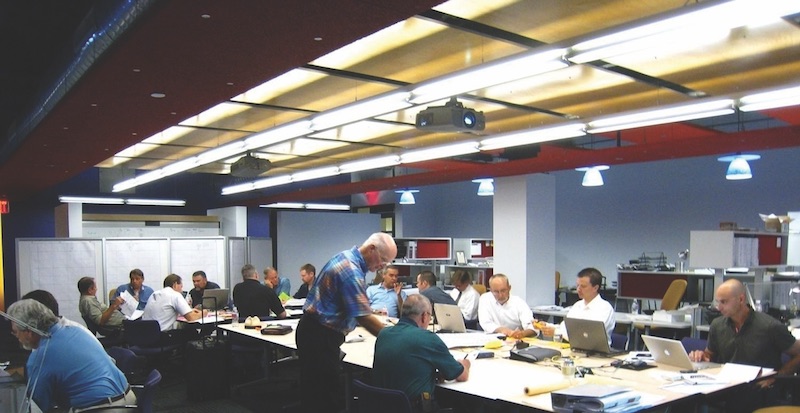 A Big Room at Sundt. The Sundt Management System (SMS) is the firm’s version of Lean 5S: 1) Sort: Remove clutter, make information less confusing; 2) Straighten: Organize the information, eliminate duplication; 3) Shine: Clean up the interface, make it more intuitive; 4) Standardize: Align project management and other business practices with recognized industry standards; 5) Sustain: Create a formal structure to develop and maintain the SMS, integrate the teaching of the system with staff career development, and measure its effectiveness within the firm.
A Big Room at Sundt. The Sundt Management System (SMS) is the firm’s version of Lean 5S: 1) Sort: Remove clutter, make information less confusing; 2) Straighten: Organize the information, eliminate duplication; 3) Shine: Clean up the interface, make it more intuitive; 4) Standardize: Align project management and other business practices with recognized industry standards; 5) Sustain: Create a formal structure to develop and maintain the SMS, integrate the teaching of the system with staff career development, and measure its effectiveness within the firm.
Five years ago, Pruitt’s successor, Dave Crawford (who retired last October), named Moreno Corporate Director of Continuous Improvement. Her brief: incorporate Lean methods not only in the field but also in administration—for payroll documentation, software development, “all our internal processes,” she says.
To date, 45 Sundt professionals have earned the CM-Lean credential. Moreno, a 12-year Sundt veteran, has implemented a “second push” to incorporate such Lean tools as Daily Huddles and Gemba walks—site walkarounds to get to the root causes of potential problems and generate solutions. (Gemba means “go to where the work takes place.”)
Moreno says the payoff for Sundt is that Lean provides “continuous flow” between members of the project team. “Lean engages our employees,” she says. (Sundt, with 2,000 staff, is employee-owned.) “Using their expertise and involvement, you get buy-in, collaboration, ideas. It’s not us [management] versus them.”
McCarthy: ‘lean helps our SUBS make their margins’
Felipe Engineer-Manriquez, PMP, LEED AP BD+C, McCarthy Building Cos.’ Corporate Lean Manager, knows that, at the very least, Lean methods can save money. Using the A3 Process, his firm avoided spending $300,000 on a vendor payment system that wouldn’t have done the job.
In Fresno, Calif., a McCarthy team building a seven-story parking garage for Community Medical Regional Center hired a Kaizen consultant to train 28 McCarthy craft workers in Lean. After only two weeks of training, they were able to identify enough time wasters to cut the concrete pour cycle from 11 days to seven—just by doing simple things like moving job boxes closer to where trade workers were actually working. Total savings: $700,000 in overtime costs. “No one had to speed up their work,” says Engineer-Manriquez. “Just by doing it right, efficiency came as a positive side effect.”
 A team from McCarthy Building Cos. meets in a Last Planner session on a TSA baggage-handling project at Las Vegas airport. The use of Lean principles saved $500,000 in overtime waste on the job, says McCarthy's Felipe Engineer-Manriquez.
A team from McCarthy Building Cos. meets in a Last Planner session on a TSA baggage-handling project at Las Vegas airport. The use of Lean principles saved $500,000 in overtime waste on the job, says McCarthy's Felipe Engineer-Manriquez.
McCarthy, an employee-owned firm of about 1,900 persons, has engaged in 60 Lean-based projects since 2014. Engineer-Manriquez, a Certified ScrumMaster (Scrum is a Lean technique that “gets twice the work done in half the time”) and an LCI-certified instructor for Last Planner and Lean Project Delivery, says, “Our subcontractors love Lean, because it produces more reliable project delivery, so they can plan their work more effectively and make their margins.”
Skanska: down to the CRAFT level
Kevin McCain, Senior Vice President of Skanska’s Seattle office, summarizes the giant contractor’s approach to Lean: “If we can make our employees’ lives easier by eliminating internal processes that are less value-added, then it gives our people more time for the value-add.”
Skanska jumped into Lean in 2007. McCain’s office was building a patient tower for Seattle’s Virginia Mason Hospital, whose entire management team had been trained in Lean principles in Japan. Says McCain, “They were using Lean to improve the patient experience,” for example, by cutting patient waiting time in the emergency department to six minutes. “We watched how they worked, and we were impressed.”
The hospital’s Lean experts trained Skanska professionals in “Rapid Process Improvement Workshop,” which helps teams identify waste and produce real change. “We now have 17 RPIWs around the country,” says McCain. “A lot of companies use pull schedules and Last Planner, but not many are implementing RPIW.”
RPIW has enabled Skanska’s Seattle office to trim the time needed to set up a project—getting insurance approvals, hiring subcontractors, etc.—from 31 days, down to 6-9 days. RPIW has also been used to connect accounting data with the company’s forecasting software. “It was taking our project managers 15 minutes to hand-enter the data into our forecasting reports,” says McCain. “Now it’s saving time for everyone in our offices around the country.”
Lean methods proved a godsend on the new Burke Museum at the University of Washington. “There was going to be a six-week delay on the building permit,” says Robert Penney, Continuous Improvement Director in the Seattle office. “We used that time to bring everyone in—the designers from Olson Kundig, subcontractors, our PMs, the field ops team—and we pull planned and resequenced how we would build the foundation, erect the structural steel, and so on. We shaved six weeks off the final schedule and came in on time.”
Under President/CEO Richard Kennedy, Skanska’s National Lean Committee (which McCain chairs) is promoting RPIWs throughout the 4,265-member firm, creating Lean education modules (such as how to use BIM 360 Plan to document pull plans), standardizing Last Planner training, and training employees to become CM-Lean certified.
“We want to bring Lean culture down to the craft level,” says McCain. “If they see something’s not working, they can stop an operation”—that’s called “pulling the Andon cord” in Leanspeak—“and take a few minutes to replan how they’re doing their work. That eliminates waste, and that’s where significant money can be saved.”
Balfour Beatty: aiding WORKER SAFETY
Balfour Beatty’s Lean roots go back 10+ years, following its acquisition of Centex in 2007. Back then, Bevan Mace, PhD, who came to Balfour from Centex, was applying Lean thinking on several mission critical, healthcare, and public assembly projects. Subsequently, he would implement Lean methods in the firm’s business acquisition and preconstruction activities.
Currently, Balfour’s Lean projects include The Pavilion for Penn Medicine, University of Pennsylvania, a 17-story hospital of 500 beds and 47 ORs, with healthcare designer HDR, architect Foster+Partners, BR+A and Southland Industries (engineering), and co-CM L.F. Driscoll, using Daily Huddles, co-location, A3, Last Planner, and IPD; and Park District, a 20-story office tower and 228-unit residential tower in Dallas for Trammell Crow and Met Life, employing pull planning, Daily Huddles, and top-down construction.
Steve Smithgall, Senior Vice President, National Operations & Safety, has been applying Lean thinking to the firm’s safety initiative. “Balfour Beatty challenged us with achieving zero harm, how to engineer out the risk,” he says. “We focused on asking why accidents happened—not just the surface causes, but the root causes. That information is shared during a weekly national leadership call on safety where we ask, What happened last week, and what did we learn from it?”
Last year, Mace, now Balfour’s Vice President, National Operations & Lean, and other Lean experts at Balfour trained all of the firm’s executives in pull planning and improving alignment with the Last Planner System. “We needed them to understand what Lean was all about from a production perspective,” he says.
Next up: a new emphasis on “visual management” in sales and operations—“knowing visually where we are against plan, where we have variances, and what we need to do.”
Skender: PUTTING ‘RAPID’ INTO ACTION
Thirteen years ago, CEO Mark Skender came back from an LCI conference convinced he wanted to implement Lean at the firm. He formed a core group of supervisors and project managers that met after work to learn Last Planner.
Their initial stab at a Lean project was Eastgate Village, an apartment complex near Chicago’s McCormick Place convention center. “At first we were just using Last Planner and Lean principles without the measurement tools,” says Afshan Barshan, then an Assistant PM.
Within a short period of time, they were adding components like Plan Percent Complete—and seeing the payoff. “Our schedules were coming 20-30% early, and we were getting better pricing and more negotiated and repeat work from clients,” says Barshan, now Executive Vice President/Partner. “The more collaborative, more productive subs wanted to work with us.” The firm’s safety rating (expressed as its Experience Modification Rate) dropped from 1.38, to 0.72. (Anything below 1.00 is better than average.)
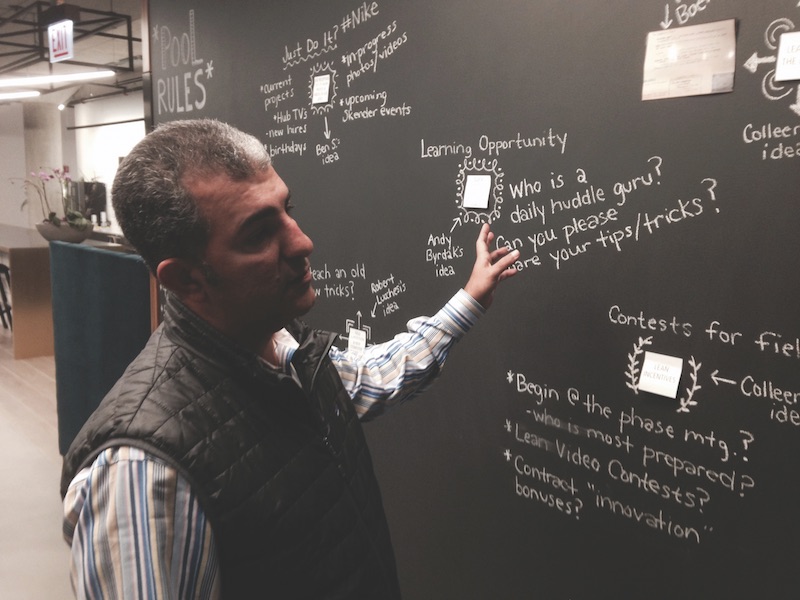 Afshan Barshan at the LEAN COFFEE board at Skender Construction’s “Hub,” where Skender staff can hold informal huddles to discuss improvements to their Lean processes. "We're embracing Last Planner as a process, whether or not the client asks us to use it," he says.
Afshan Barshan at the LEAN COFFEE board at Skender Construction’s “Hub,” where Skender staff can hold informal huddles to discuss improvements to their Lean processes. "We're embracing Last Planner as a process, whether or not the client asks us to use it," he says.
Skender’s latest foray into Lean tools is its deployment of Rapid Action Teams. With RATs, says Barshan, “you have 90 days to figure out your current process, Value Stream it, and make recommendations for improvement.”
Their first RAT attacked the firm’s document control system. “The team eliminated several redundancies and came up with a mostly electronic filing system.” The contractor is now on its eighth RAT. The latest will help it choose the best software for performing Lean operations.
Mark Skender’s vision for Lean has been fully adopted by the 226-member staff. Says Barshan, “We’re embracing Last Planner, whether or not the client asks us to use it.”
JE Dunn: TAKING THE PLUNGE
JE Dunn’s first Lean project was a complete leap of faith. Five years ago, the firm took on a $6.1 million, 52,000-sf renovation of two residence halls at Huston-Tillotson University, Austin, Texas. The initial work plan called for a 28-week schedule that would have displaced 196 students during the school year and cost as much as $300,000 in lost housing fees—dollars the historically African-American institution could hardly afford.
Despite having no previous experience in Lean-based work, JE Dunn quickly implemented a Last Planner training program for its Houston office and its subcontractors, 90% of whom had never heard of Lean.
Working with Austin firm CasaBella Architects, the GC used Last Planner and Daily Huddles to cut the schedule to 12 weeks in the summer—meaning no disruption to students, no lost housing fees for the university, and better pedestrian safety during construction. They even sidestepped four months of General Conditions costs.
Since then, JE Dunn has developed several specific Lean-related techniques. “We use Strategyzer’s Value Proposition Canvas to build team clarity around the value of projects,” says Rebecca Snelling, the firm’s National Director of Lean Construction. “We use that as the baseline to create Conditions of Satisfaction, while converting the project’s Value Proposition into a Graphic Master Schedule for the project.” The firm has also developed a proprietary platform, Lens, for rapid conceptual estimating.
The 3,100-person firm is taking Lean into its internal business processes. It’s using Last Planner to respond to RFPs, Value Stream Mapping to increase diversity, and Kanban to enhance its communications. It’s holding 15-minute standups in its IT, Quality, and Marketing units.
Says Snelling, who chairs the Lean Construction Institute Education Committee, “Lean is not just for [building] projects.”
Dan C. Heinemeier, CAE, LCI’s Executive Director, says a number of LCI member firms are doing what JE Dunn, Gilbane, Balfour Beatty, Sundt, and other AEC firms are doing—implementing Lean on an “enterprise” basis. “It’s a new direction, getting Lean into everything they do in their business and getting everybody in the firm to be much more Lean,” he says.
moving on: lEAN’S THIRD DECADE
“Lean is about change across organizations, not just your organization,” says Balfour’s Bevan Mace. “In construction, you create a different culture on every job.” The industry has to “get better at improving the speed at which we create good Lean cultures on each project.”
Still, achieving “continuous improvement” is “not as easy as you think,” says Sundt’s Melissa Moreno. “You’re talking about changing the culture, changing behavior, and getting people committed to the idea. But when people can see the value in their work and in their daily lives, when we reduce wasted time and help them go home early and go home safe, that increases engagement.”
Related Stories
Women in Design+Construction | Jan 25, 2024
40 Under 40 Class of 2023 winner Kimberly Dowdell inaugurated as AIA 2024 President
The American Institute of Architects (AIA) has announced the inauguration of Kimberly Dowdell, AIA, NOMAC, NCARB, LEED AP BD+C, Principal and Director of Strategic Relationships at HOK and BD+C 40 Under 40 superstar, as its 100th president.
AEC Innovators | Mar 3, 2023
Meet BD+C's 2023 AEC Innovators
More than ever, AEC firms and their suppliers are wedding innovation with corporate responsibility. How they are addressing climate change usually gets the headlines. But as the following articles in our AEC Innovators package chronicle, companies are attempting to make an impact as well on the integrity of their supply chains, the reduction of construction waste, and answering calls for more affordable housing and homeless shelters. As often as not, these companies are partnering with municipalities and nonprofit interest groups to help guide their production.
AEC Innovators | Feb 28, 2023
Meet the 'urban miner' who is rethinking how we deconstruct and reuse buildings
New Horizon Urban Mining, a demolition firm in the Netherlands, has hitched its business model to construction materials recycling. It's plan: deconstruct buildings and infrastructure and sell the building products for reuse in new construction. New Horizon and its Founder Michel Baars have been named 2023 AEC Innovators by Building Design+Construction editors.
40 Under 40 | Oct 19, 2022
Meet the 40 Under 40 class of 2022
Each year, the editors of Building Design+Construction honor 40 architects engineers, contractors, and real estate developers as BD+C 40 Under 40 awards winners. These AEC professionals are recognized for their career achievements, passion for the AEC profession, involvement with AEC industry organizations, and service to their communities.
Movers+Shapers | Nov 7, 2021
Passage of $1.2 trillion infrastructure bill expected to spur stronger construction activity
AEC firms see federal investment as historic
Movers+Shapers | Apr 30, 2020
College programs help prepare students for careers in the construction industry
Universities with AEC programs hone their curricula and research to prepare students to hit the ground running in the construction industry.
Movers+Shapers | Apr 21, 2020
Management Training: AEC firms bring students into the real world
Students benefit substantively from internships offered by AEC firms.
Movers+Shapers | Apr 17, 2020
Meet the ‘AEC outsiders’ who are helping to push the industry into the new decade
AEC professionals have enough on their plates without becoming specialists in a new skill outside of their wheelhouse.
Movers+Shapers | Apr 15, 2020
Buildings as "open source platforms"
NBBJ’s year-old Design Performance Group helps building teams make smarter choices earlier.
Movers+Shapers | Apr 23, 2019
Steely resolve: Carnegie Mellon University fuels Pittsburgh's post-industrial reinvention
After the steel industry started collapsing in the late 1970s, Pittsburgh has been reinventing itself as a science, medical, and academic hub.


